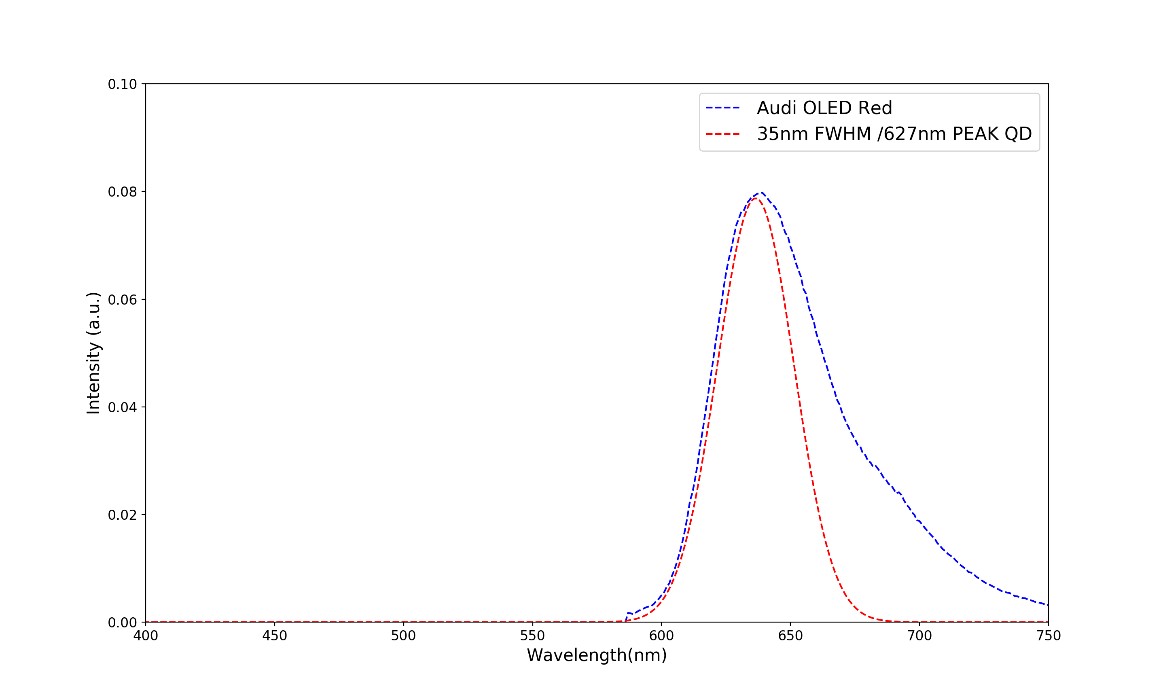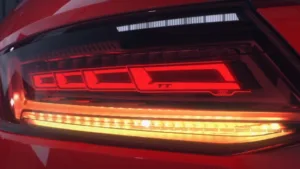I’m finding myself thinking more esoterically about colors and perception lately. We all know color matters in displays, it’s one of the defining features of QLED technology. You might have seen my last article that mentioned QLEDs for auto tail lights as a possible replacement of OLED tail lights.

Let me take you for a walk down the meandering path my mind can take that I think might have some value to an those of you who think about color (almost) as much as I do.
Why are cars using OLED tail lights?
The main reason manufactures are looking to OLED is for flexibility in design which leads to a more marketable vehicle. I doubt there is an efficiency reason to put OLEDs instead of red LEDs on a vehicle, but with OLEDs you get a distinctly different look. Smooth, large area sections that can be freely split up into multiple lights so that unique patterns can be displayed. Perhaps just a novelty, but just like displays, car manufactures are looking for every edge they can get in a competitive market. In the end, they just look cool. This got me thinking about other benefits of new lights sources in vehicles. Are they brighter? Can following cars see the OLED brake lights better? Is the color unique? Does color impact how they tail lights are perceived? Color… ahh yes, color!
Audi’s red OLED tail light. They even made room for a mini “TT” and Audi rings in there!
This is probably not the right forum to dive into photopic response curve, rods and cones, etc. But I did some digging in the technical literature and found a few interesting studies that looked at how reaction time and color are related. I think you’ll find this interested. Maybe you can already see where this is headed?
In a 2014 paper, one group studied the reaction time of 50 people and determined that there was a statistically significant difference in their reaction time to red vs green light (Int J Clin Exp Physiol, 2014, 1:311-3). Reaction time to green light was about 30% longer than red light. Think about the difference that might make if you are tailgating someone on the highway! Maybe this is why tail lights were chosen to be red instead of green (other theories welcome).
It turns out researchers have also determined that red makes us react more strongly (a strange concept, I know). Probably a good response when you need to slam on the brakes really hard to avoid a collision.
“Harder – Better – Faster – Stronger”
Ok, so maybe Daft Punk was not referring to human response to red lights, but this is a field trip down my non-linear thought process, not yours. The next obvious question is – does the color of red matter? Brake lights are red everywhere in the world, but not all reds are created equal as those of us who worrk in display technology well-know. For decades, brake lights were just red plastic over a white incandescent bulb, but those days are coming to an end. Now red LED lights are common, and red OLED becoming an increasingly popular choice. Is there any reason electroluminescent(EL) -QLEDs couldn’t be used for tail lights instead? How do they stack up against OLED?
 Measured spectrum of a red OLED from an Audi tail light compared to a red QD spectrum. OLED spectrum courtesy of Matthew Bertram and his trusty spectrometer, thanks Matt!
Measured spectrum of a red OLED from an Audi tail light compared to a red QD spectrum. OLED spectrum courtesy of Matthew Bertram and his trusty spectrometer, thanks Matt!
Comparing the spectra of red QD to red OLED, you can clearly see that the QD peak is much narrower, which will lead to a more saturated red color. Also, one of the reasons we love QDs for displays is that they are wavelength-tunable. In theory we could create any red/fuchsia/crimson/burgundy color that we wish (assuming the Department of Transportation will allow it). We need only to look to Crayola for inspiration. Will the choice of color impact reaction time further? Will lights with different hues of red be more visible in poor driving conditions? I’m acutely aware that I’m asking more questions in this blog than I am able to answer, so I welcome your comments.
 Just look at all the various shades of red that Crayola has invented!
Just look at all the various shades of red that Crayola has invented!
It’s probably worth pointing out that red LED peaks can be even more narrow than the OLED or QD peak (15-20 nm FWHM according to OSRAM data sheets), which is worth considering if you are willing to forgo the “cool” factor of OLED tail lights and design freedom it allows. But I’m thinking esoterically here, remember?
EL-QLED tail lights might actually have a leg to stand on if someone can prove that the tunability of the spectrum, or the pure color emission have some advantage in safety over other forms of red (LED Or OLED). They naysayers will tell you that EL-QLEDs are still a long way off (and they are for displays), but let me remind you of this – if there is one color of EL-QLED that is closest to product-ready, it’s red (cadmium containing of course). Red EL-QLED should have all the same advantages as red OLED in terms of flexibility, viewing angle, design, and EL-QLED might even win on brightness and color.
If anyone wants to test reaction time and perception of different colors of red tail lights, I’ll gladly be a test subject (especially if I get to drive the Audi!).
Peter Palomaki is the owner and chief scientist at Palomaki Consulting, a firm specializing in hands-on assistance to help solve big problems at the nanoscale. He uses his deep technical expertise in quantum dots and materials chemistry to improve existing products and develop new technologies.

